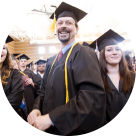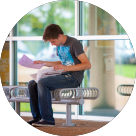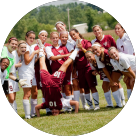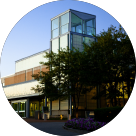Recently Visited Pages
Take advantage of this at-a-glance look at the pages on the SCC website you most often visit. Use this as a tool to navigate quickly to info you need the most. Take it one step further and click the star in the top right corner to ensure your favorite pages remain on your list of Visited Pages.
Reopening Plan
| Definition of Covid-19 |
SCC Covid-19 Timeline |
SCC Reopen Plan - Organizational Overview |
Reopening-Informed Decision-Making |
References Cited |
DEFINITION OF COVID-19
COVID-19 is a respiratory illness caused by the novel coronavirus (SARS-CoV-2). The virus spreads from person-to-person primarily through respiratory droplets and contact with contaminated surfaces. It is a particular threat for older patients and those with certain pre-existing medical conditions.1 However, there is much to learn about the virus and to consider in the context of risk and risk mitigation for SCC populations.
The Pandemic Committee drew on a wide range of resources in developing its recommendations. This included guidelines from the Centers for Disease Control and Prevention (CDC), the Missouri Department of Health and Senior Services, the Missouri Governor’s Office, St. Charles County Department of Public Health and other government agencies and professional organizations. Committee members conducted literature and data reviews, including COVID-19 case and hospitalization rates for Missouri. Leadership has remained in close contact with other academic institutions in the state reviewed plans and white papers from other higher education institutions across the country.
In developing these recommendations, we are operating under the assumption that there will continue to be some degree of spread in the community during the Fall semester and beyond until (if) herd immunity is achieved either through vaccination or actual infection and recovery. While therapy and vaccine development are underway and early clinical trials have begun, to date no vaccine or prophylactic drugs with proven safety and efficacy exist.
Thus, as St. Charles Community College (SCC) reopens, the primary tools to limit the viral spread and harm are prevention through a combination of personal and public health practices, and supportive therapy. The Committee’s recommendations, wherever possible, are evidence-based and intended to facilitate faculty, staff, and students returning to campus as safely as possible.
This involves balancing risk with benefit. The duration of this pandemic remains unclear, and the situation is dynamic and continues to develop. The Committee will regularly review public health guidance, scientific knowledge, and clinical best practices and update its recommendations as the need arise.
SCC COVID-19 TIMELINE
MID-FEBRUARYBegan discussing |
FEBRUARY 28Established |
MARCH 3Decided to move spring break to online/remote work schedules. Established Committees
|
MARCH 9Suspended IT establishes resource |
MARCH 12FA Association established President’s Council |
MARCH 13College provided 2 online President began daily All college travel |
MARCH 16-20IT distributed laptops, etc. to Housekeeping staff cleaned & |
MARCH 18All spring events Commencement |
MARCH 19SCC Foundation donated $21,403 Vice President Leenhouts presented comprehensive plan for College extended remote |
MARCH 20Human Resources Food items were donated |
MARCH 26College decided |
MARCH 27Medical |
MARCH 30Board conducted first In the spirit of preparation, CARES Act passes. $2.6M |
APRIL 1Access to most buildings Gov. Parson announces |
APRIL 3Administration decides Gov. Parson issues Stayat-Home Order. |
APRIL 6Cabinet subcommittee formed |
SCC REOPEN PLAN – ORGANIZATIONAL OVERVIEW
The St. Charles Community College Pandemic Committee is providing leadership to develop plans associated with the delivery of instructions and support services amid the COVID-19 pandemic. The Committee is led by Todd Galbierz, COO/Vice President for Administrative Services. Guided by the college’s existing Pandemic Plan, the group met on a regular basis to gather data and other resources, assess appropriate strategies for maintaining compliance with safety standards, and communicating key information to the campus community. The most important work associated with this group is determining how the process for reopening the campus in a manner that maintains social distancing and other appropriate measures, including:
- State of COVID-19’s impact in the state’s hospitals
- Contact monitoring and tracing
- Prospect for and the impact of widespread availability of:
- Treatments (antivirals)
- Serological/antibody testing
- COVID-19 virologic testing
- Vaccines
Additional sub-groups have been created and are associated with the Pandemic Committee.
These include:
- The Continuity of Instruction Group
- The COVID-19 Facility Task Force
To date, 69 faculty and staff have been involved in planning and have contributed to this Reopen Plan.
We wish to acknowledge the following individuals for their assistance:
| Diane Arnzen William Bailey Frank Barrow Lauren Bauer Beth Bauer John Bookstaver Jeff Bradbury Ken Bray Kathy Brockgreitens-Gober Gretchen Carranza Andrea Compton Boyd Copeland Donna Davis Marcus Davis Tim Davison Tammie De Los Santos Lauren Dickens |
Mike Dompierre Jeffrey Drake Brad Egberts Jerol Enoch Justin Enoch Theresa Flett Todd Galbierz Karen George Lance Gully Virginia Guneyli Borys Hlubotskyy Martha Kampen Brenda Kearns Barb Klasek Amy Koehler David Leenhouts Kelli Lile Holly Martin |
Heather McDorman Kelleagh McGraw Lindy McGuire Rex McKanry Cory McRae Victor Mercurio Lisa Mouser Joanna Musak Darren Osburn Julie Parcel Nicole Pinaire Don Popham Bob Ronkoski Mandy Rose Nikki Ruckman Jay Scherder Betsy Schneider Diana Schoo |
Dave Schuckmann Joe Schuchmann David Seward Sana Shaheen Chad Shepherd Monica Swindle Doug Threewitt Ginny Tiller Mercedes Tolliver Jusuf Tucakovic Scott Vierling Mara Vorachek-Warren Rich Waligurski Nick Wallace Mathew Wills Dave Wilmore Victoria Young |
Restart Framework
The Committee has aligned with the guiding principles outlined in the Show Me Strong Recovery Plan published by the State of Missouri on May 4, 2020. These guiding principles frame the decision to move forward with stages to reopen various sectors of the economy:
- Flattening the curve and expanding healthcare capacity, while utilizing federal programs and deploying state resources;
- Making decisions based on Missouri-specific data and medical expertise;
- Protecting healthcare workers, first responders, and other direct care workers so that our citizens have access to the care they need;
- Looking after our most vulnerable and at-risk populations;
- Partnering with community leaders and incorporating flexibility based on each community’s circumstances;
- Slowing and containing the spread of COVID-19;
- Implementing a measured approach to mitigate risk of a resurgence.
Guiding Principles and Premises for the Committee
- A phased approach is needed for the return to the campuses.
- Herd immunity will not have been achieved at the time of return to campus.
- Vaccines against SARS-CoV-2 will not yet be available at the time of return to campus.
- Approximately 40-50% of individuals infected by SARS-CoV-2, and capable of shedding virus, are asymptomatic.2
- A variety of risk mitigation and monitoring strategies need to be in place. Further strategies should be considered as technologies advance and more data becomes available.
- In the event of a resurgence, criteria and procedures need to be in place for a campus or campuses to shut down rapidly.
- If viral spread continues to decrease, restrictions may be relaxed in a phased approach.
- Plans to return to campus may differ for credit and non-credit programs.
- Special consideration must be given to the individual susceptibilities of vulnerable populations within the faculty, staff, and student community.
- The variations among campuses must be considered and locations must abide by local health department guidelines.
- Faculty and staff should continue working on a remote basis if feasible, or until directed to return to campus by Human Resources.
- Clarity of roles and responsibilities of SCC, the Missouri State Department of Health and Senior Services, and local health departments is important.
- The “dose” of exposure matters so reducing the amount of exposure to the virus to the lowest levels possible is warranted.
REOPENING – INFORMED DECISION-MAKING
Modeling and Health Systems Capacity and Survey Data
- The SCC Pandemic Committee will continue to monitor current data, trends in new hospitalizations, and regularly updated modeling for Missouri.
- The data from the Missouri Department of Health and Senior Services and St. Charles County Department of Public Health have had and will continue to have significant Intensive Care Unit (ICU) and ventilator capacity. The Pandemic Committee will continue to monitor trends.
- Ultimately, the timeline for restarting activity depends on the extent of viral spread, which can and will change over time. These current modeling projections and health system tracking data support a phased return to campus, with risk mitigation, and tracking procedures to be described below:
- Staff, as needed and identified, may be returning to campus beginning in June-July,
- The return of athletes for training and competition has not yet been determined (see Athletics section),
- Faculty and student body to return (in some proportion) for fall semester .
To finalize plans for the fall semester, SCC requested feedback from the campus community through the survey of faculty and students. The hybrid approach was based off of the feedback received.
|
STUDENT SURVEY RESULTS SHOWED:
|
FACULTY SURVEY RESULTS SHOWED:
|
To maintain health guidelines and ensure social distancing, courses and services will return to campus for the fall in a reduced capacity.
- Courses will be delivered via a hybrid approach. Limited face-to-face courses will be offered on campus with the majority of courses being offered online.
- Classrooms will be set-up to ensure social distancing can be maintained.
- Buildings will be marked to ensure the flow of traffic ensures social distancing can be maintained.
- Student services will be offered by appointment including enrollment, financial aid and advising.
REFERENCES CITED
1 CDC. (2020). People Who Are at Higher Risk for Severe Illness. Retrieved from https://www.cdc.gov/coronavirus/2019-ncov/need-extra-precautions/people-at-higher-risk.html
2 Arons, M. M., Hatfield, K. M., Reddy, S. C., Kimball, A., James, A., Jacobs, J. R., . . . Jernigan, J. A. (2020). Presymptomatic SARS-CoV-2 Infections and Transmission in a Skilled Nursing Facility. N Engl J Med. doi:10 .1056/NEJMoa2008457
3 Davies, A., Thompson, K.-A., Giri, K., Kafatos, G., Walker, J., & Bennett, A. (2013). Testing the efficacy of homemade masks: would they protect in an influenza pandemic? Disaster medicine and public health preparedness, 7(4), 413-418. doi:10.1017/dmp.2013.43
4 Howard, J., Huang, A., Li, Z., Tufekci, Z., Zdimal, V., van der Westhuizen, H.-M., . . . Rimoin, A. (2020). Face Masks Against COVID-19: An Evidence Review. Preprints.org. doi:10.20944/preprints202004.0203.v1
Sources Used by the Committee Include:
In addition to the many data sources used by committee members in their professional duties, the following have also been considered:
CDC. (2020). Appendix F: Guidance for Implementing the Opening of America Again Framework. Centers for Disease Control and Prevention.
CDC. (2020). COVID-19 Guidance for Shared or Congregate Housing. Centers for Disease Control and Prevention. Retrieved from https://www.cdc.gov/coronavirus/2019-ncov/community/shared-congregatehouse/guidance- shared-congregate-housing.html
CDC. (2020). COVID-19 Travel Recommendations by Country. Centers for Disease Control and Prevention. Retrieved from https://www.cdc.gov/coronavirus/2019-ncov/travelers/map-and-travelnotices.html
CDC. (2020). Global COVID-19 Pandemic Notice. Center for Disease Control and Prevention. Retrieved from https://wwwnc.cdc.gov/travel/notices/warning/coronavirus-global
CDC. (2020). Healthcare Infection Prevention and Control FAQs for COVID-19. Retrieved from https://www.cdc.gov/ coronavirus/2019-ncov/hcp/infection-control-faq.html
CDC. (2020). Interim Guidance for Administrators of US Institutions of Higher Education. Retrieved from https://www.cdc.gov/coronavirus/2019-ncov/downloads/guidance-administrators-college-highereducation.pdf
CDC. (2020). People Who Are at Higher Risk for Severe Illness. Retrieved from https://www.cdc.gov/coronavirus/2019-ncov/need-extra-precautions/people-at-higher-risk.html
CDC. (2020). Quarantine and Isolation. US Federal Government. Retrieved from https://www.cdc .gov/coronavirus/2019-ncov/if-you-are-sick/quarantine-isolation.html
CDC. (2020). Reopening Guidelines. Retrieved from http://cdn.cnn.com/cnn/2020/images/04/30/reopening. guidelines.pdf
American College Health Association. (2020, March 3). ACHA Guidelines: Preparing for COVID-19. Archer-Daniels-Midland Company (ADM). (2020, May). Return to the workplace, COVID-19: Strategy,process, tactics.
Centers for Disease Control and Prevention. https://www.cdc.gov/ Centers for Disease Control and Prevention. (2020). Coronavirus Disease 2019 (COVID-19): Workplace decision tool.
Centers for Disease Control and Prevention. (2020, February). Interim guidance for businesses and employers to plan and respond to coronavirus disease 2019 (COVID-19). Centers for Disease Control and Prevention. (2020, March 3). Coronavirus disease 2019 (COVID-19) outbreak.
Centers for Disease Control and Prevention. (2020, March 10). Interim guidance for emergency medical services (EMS) systems and 911 Public Safety Answering Points (PSAPs) for COVID-19 in the United States.
Centers for Disease Control and Prevention. (2020, March 14). What law enforcement personnel need to know about coronavirus disease 2019 (COVID-19).
Choi, Mun. (2020, March 17). Enhanced UM system HR polices for staff and faculty [Personal communication]. University of Missouri System.
Cushman & Wakefield. (2020). The safe six: Workplace readiness essentials.
East Central College. (2020, May 13). East Central College return to campus plan.
Johnston, Susan Whealler. (2020, March 19). Families First Coronavirus Response Act: Public employer tax credit exclusion [Personal communication]. National Association of College and University Business Officers.
Kansas City Kansas Community College. (2020, May 11). Blue Devils comeback plan. Lear Corporation. (2020, April 6). Safe work playbook.
Missouri Department of Higher Education & Workforce Development. (2020, March 17). COVID-19 update meeting.
Missouri Office of Administration. (2020, March 16). COVID-19: Frequently Asked Questions in the workplace.
OSHA. (2020). COVID-19 related guidance. Occupational Safety and Health Administration. Retrieved from https://www.osha.gov/SLTC/covid-19/
Parson, M. L. (2020, April 27). Show Me Strong recovery plan: Phase 1. State of Missouri.
Society for Human Resource Management. https://shrm.org/
Steelman, S. (2020, March 16). Re: Leave guidance related to Coronavirus Disease 19 (Revision 1). Missouri Office of Administration.
Tueth, Keeney, Cooper, Mohan & Jackstadt, P.C. (2020, March 20). Families First Coronavirus Response Act – Update for public education employers regarding family and paid leave requirements.
U. S. Department of Labor. (n.d.). COVID-19 and the American workplace. https://www.dol.gov/agencies/whd/pandemic
U. S. Equal Employment Opportunity Commission. (n.d.). Coronavirus and COVID-19. https://www.eeoc.gov/coronavirus
The White House. (2020, April 17). Opening up America again.
Williams, Randall W. (2020, April 27). Economic reopening order. Missouri Department of Health and Senior Services.








